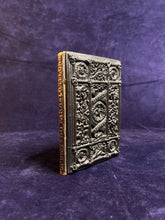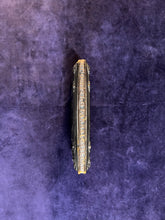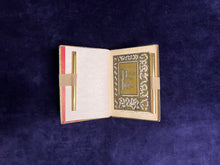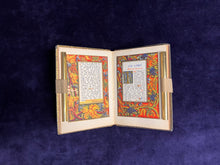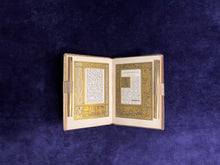
Henry Noel Humphrey, Parables of Our Lord. London: Longman. 1847.
FIRST EDITION (170 x 120mm) pp. 32, ii. All edges gilt, red end papers, & illustrated title page. Original black papier mâché cover. Very minor bumping to corners, some expected cracking but all in all intact and good condition. Spine shows a minor split.
An increasingly rare & sought-after fragile memory of the Victorian enthusiasm for the Middle Ages, Humphry’s Parables of our Lord combines Gothic-style chromolithographic illumination with the weighty book art of papier mâché covers to create a Neo-Gothic gift book of biblical passages describing the miracles of Christ. In the same way that sumptuous medieval manuscripts in the High and Late Middle Ages demonstrated the conspicuous consumption of their lay patronage, this nearly-overwrought package of color and texture was intended to be on display in the home of the affluent Victorian socialite who owned it.
Chromolithography— an illustration process pioneered in the 19th century which involves layering colors onto a stone which is the medium of print to produce bright, multi-colored pictures— was pioneered in the 19th century and Humphreys’ use of the technique creates a Neo-Gothic wonderland of illuminated and inhabited initials, borders, and miniatures. The borders are fancifully adapted versions of Gothic acanthus and vinework as well as Dutch 15th and 16th century strewn borders— a Victorian update on the sumptuous late Gothic pinnacle of conspicuous consumption. The original intention was for these books, of which it is said there were only 1,000 made for the English market, was to be presented as gifts. Only 8 titles received this gutta percha/ papier mâché binding style, emulating the ebony treasure bindings of their medieval models.
Humphrey’s Miracles of Our Lord (1848) immediately followed the publication (and commercial success) of this book.





